Breaking down a business-like win in Atlanta with an eye towards the showdown with Clemson – can the Irish expect some positive regression creating explosive plays and gaining turnovers? How does the efficiency of rushing and passing this year compare so far? And what else should Brian Kelly, Clark Lea, and Tommy Rees be thinking about before facing the Tigers?
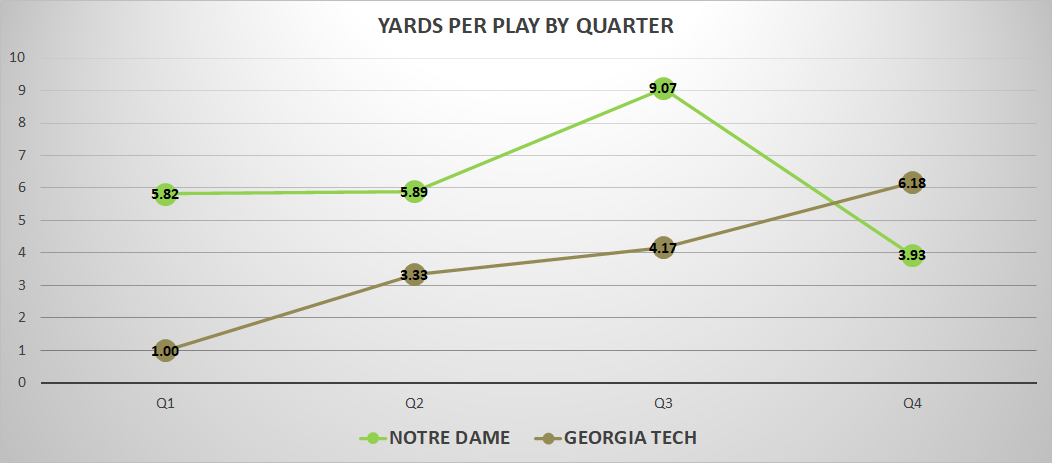
The late periods of this contest were right on the edge of garbage time definitions. By the book garbage time is in action with a 22-point or greater lead in the 4th quarter, which the Irish established but gave back. There are clear signs the Notre Dame offense had downshifted, with just two passes in the last 15 minutes. Still, I like to err on the side of including more plays rather than fewer, so ultimately did not throw out any plays in this one. But it’s worth noting that with Brian Kelly’s team in clear control, things may have eased up as the game went on, as you can see above.
Explosiveness
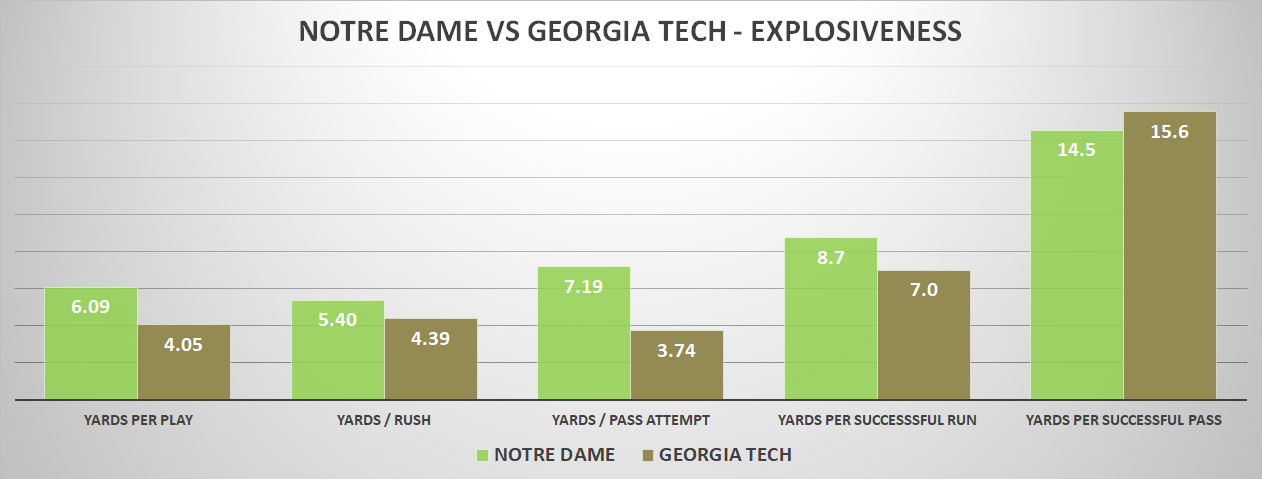
This was a pretty ho-hum win with +2 yards per play margin for the guys in gold helmets. Choose your favorite adjective – workmanlike, methodical, efficient – the Irish had an early hiccup but otherwise cruised through a less talented opponent. It wasn’t flashy but generally hit all the checkpoints – passing over seven yards per attempt, runs over five, and limiting Georgia Tech to just three scoring chances late.
One thing that’s been on mind this season is the balance between explosiveness and efficiency. Explosiveness is more predictive on a single-game basis, but one of Bill Connelly’s most important findings is that explosiveness is mostly random. Success rates have been shown to be stable between the first and second half of the year, while explosiveness regresses to the mean. The Irish have held a massive efficiency advantage all season, but that hasn’t necessarily translated into explosiveness (yet), where they are very average on both sides of the ball (without adjusting for opponents).
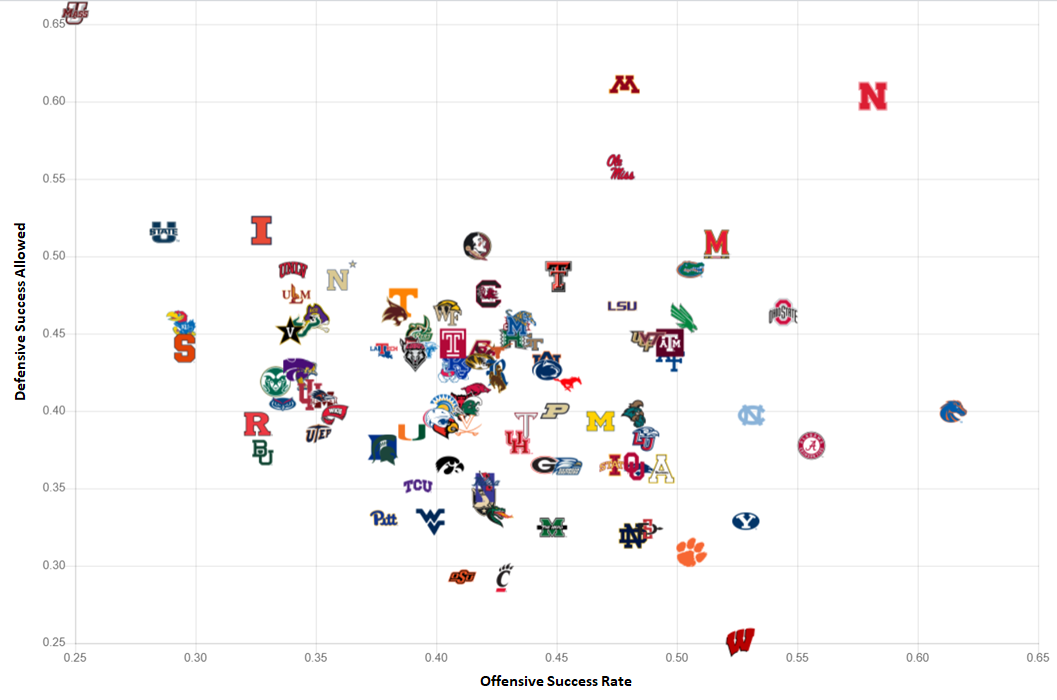
National Offensive and Defensive Success Rates – opponents haven’t been good, but the efficiency has been! (Bottom right = good)
Can we expect some positive regression here? I’d be on at least a little, although the things that at the micro-level you’d like to see produce explosive plays (top-flight talent at skill positions, scheme aggression with downfield throws) aren’t necessarily there. In the running game, we saw a few plays where Kyren Williams and Chris Tyree were a cut or missed tackle away from a long touchdown. Putting on a game-state lens, it’s also reasonable to assume a little bit of the big-play lethargy is due to leading almost the entire season and not running as many plays as usual.
At this point, it’s a fair assessment to say that the Irish will need to intentionally work all season to manufacture explosive passing plays. The current receiving rotation has many strengths, but the ability to create something out of nothing after the catch isn’t one of them. It’s noticeable sometimes when the Irish go play-action and Book is immediately looking deeper downfield that Tommy Rees is trying to set these opportunities up, but it’s really dependent on the first read or two being open and not quite in the natural flow of the offense. Still, those shots (and attempting them in many ways – sideline passes to McKinley or Skowronek, wheel routes to the RBs, tight ends down the seam) are vital to take and necessary to keep defenses honest.
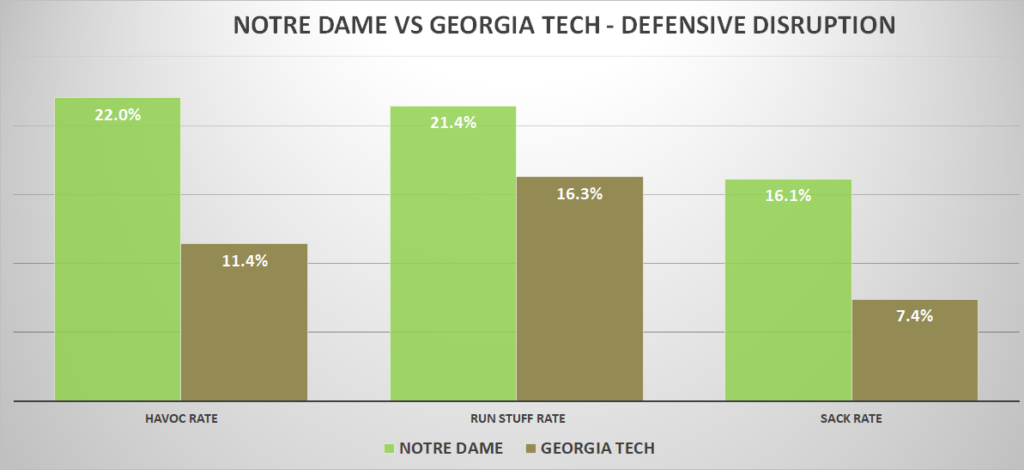
The Irish defense continues to be extremely disruptive, with a sixth consecutive week with a havoc rate over 20%. The only power five teams that have a higher havoc rate for the season than Notre Dame (24%) are temporary conference-mates Pitt (25%) and Clemson (25.5%). Both of those teams have given up far higher rates of explosive plays than the Irish, so Clark Lea has thus far found a nice balance to strike between aggression and big-play prevention.
Entering this game it was a strong bet that Georgia Tech’s passing attack would struggle, but limiting the Yellow Jackets to 3.7 yards per passing play is still impressive. After a few weeks of pressure and strong passing down success, the Irish finally landed a season-high five sacks, highlighted by a pair from Daelin Hayes. One exciting element heading into this weekend is what the defense may look like with Clark Lea tightening the rotation a bit – don’t expect to see JOK and others to come off the field much if at all Saturday night. The secondary, which has shown some susceptibility against long passes, may finally be fully functional after Kyle Hamilton’s early injury and COVID impacting Clarence Lewis, Nick McCloud, and Tariq Bracy.
Efficiency
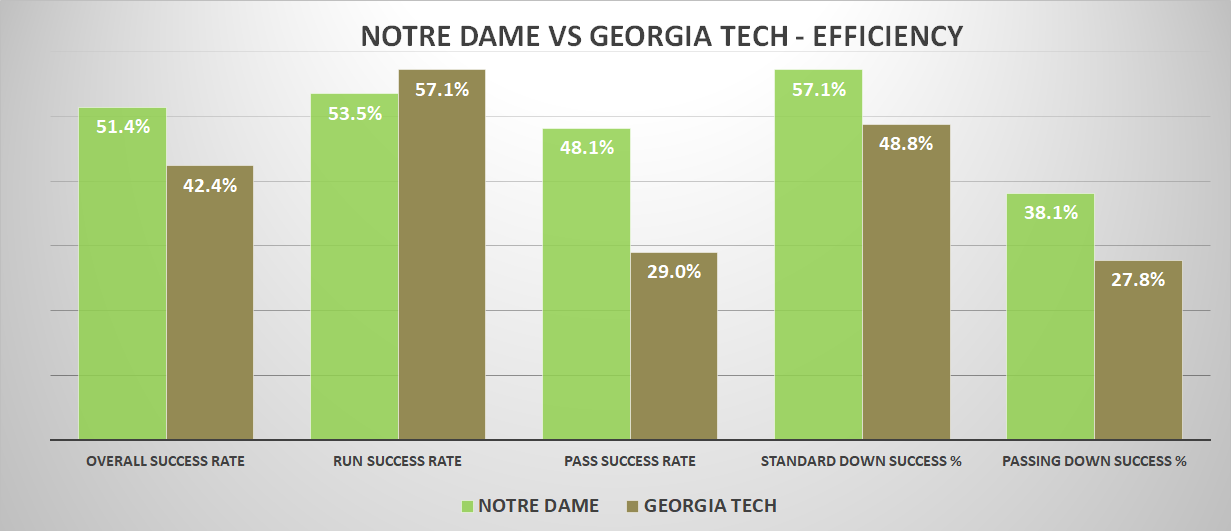
Georgia Tech put up far better efficiency numbers than expected – it seemed like with a dependence on true freshman and lack of passing game, this could be a repeat of Pitt’s offensive performance. The Yellow Jackets took a page from Notre Dame’s book and were solid in their situational runs, with the exception of the 4th and 1 attempt Kyle Hamilton swallowed up. Many of these successful runs also took place in situations (2-minute before halftime, late in the game) where the Irish were probably ok with it. Nothing to worry about here, or at least change how worried you’ve been about Travis Etienne.
This passing performance was firmly in the “Book Nook” range where the veteran QB lived for almost all of 2018 – greater than seven yards per pass attempt and well above average (40%) pass efficiency. A lack of designed runs the week before Clemson was no surprise, but Book’s scrambling continues to be an effective weapon with eight yards per rush.
If we take this pause to check in on the season-long statistics (excluding USF as non-P5 competition) there’s a good bit of balance between run and pass success. Both have been very efficient with the run game with a slight edge that may be built off the strong performances in 3rd and short. The passing game has still averaged more than 1.6 more yards per play and nearly doubled the explosive play rate (as measured by 12+ yard gains).

The run-pass dynamic against Clemson will be heavily scrutinized but I’m not sure there’s a “right answer” heading in. Much will depend on how aggressive the Tigers defense is with men near the line of scrimmage and smart situational moves (throwing on 2nd and long, rushing to keep to a low possession game when advantageous, calling smart 3rd down plays in 4-down territory).
Defensively the Irish remain elite at limiting opponents on passing downs (3rd among P5 teams playing more than two games). Forcing these situations that limit the playbook and allow the pass rush to tee off will be crucial against DJ Uiagalelei and company, but requires excellent early down execution.
Finishing Drives, Field Position, & Turnovers
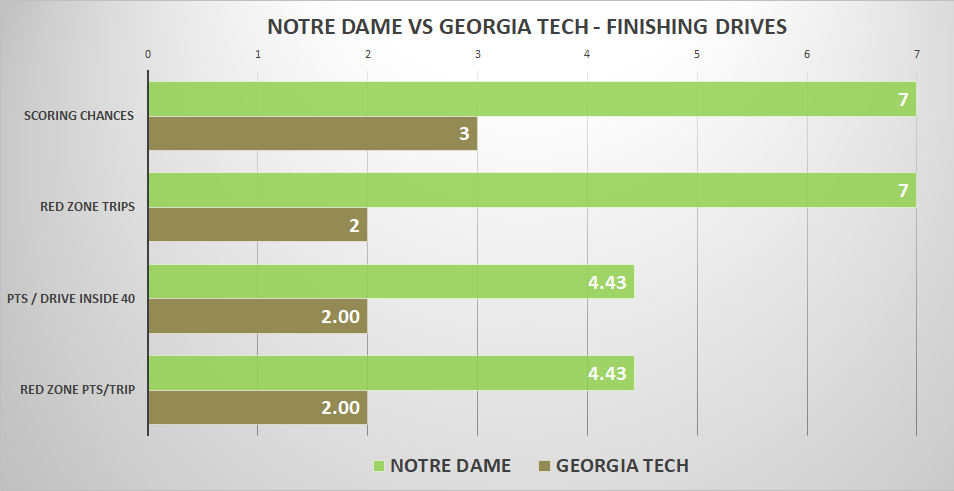
Over the last three games against Louisville, Pitt, and Georgia Tech, the Irish have created 19 scoring opportunities (1st downs inside the opponent 40-yard line) while allowing just seven. The Kyren Williams fumble was the only missed opportunity on the day, and overall it’s a strong sign when only one drive stalls out for a field goal attempt. On the other side of the ball, the Irish defense held up well on a short-field, with a strip-sack ending one possession and almost a second that ultimately ended with a missed field goal.
The Irish won the field position battle by an average of 5 yards per possession, another very healthy sign despite the onside kick recovery allowed. Special teams for the year have felt very underwhelming – Jonathan Doerer hasn’t had many chances but missed some uncharacteristic kicks, Jay Bramblett has been just a touch better in net yardage than last year, and the punt return game now feels fully in fair catch mode.

On the surface Notre Dame was slightly unlucky with turnovers in this game, and that’s exacerbated when the annual red zone fumble returned for a TD is accounted for. With the randomness of turnovers, some negative regression was expected from the Irish and they are feeling that so far in 2020.
The defense forced 1.5 fumbles a game in 2019 but that’s been sliced by over half to 0.7 this fall. Last season the guys in gold helmets grabbed 57% of fumbles forced but that’s declined to 38% in 2020. Notre Dame is averaging slightly more pass break-ups per game (up to 4.7 from 4.0) but intercepting fewer of them (from 17% to 14%). Both of these rates are unlucky – a team should expect to recover 50% of fumbles and intercept about 22% of PBUs – so expect things to get better in the second half.
Clemson Sneak Peek
If Brian Kelly can admit the team has been looking ahead and Daelin Hayes can immediately announce in the locker room “It’s Clemson week”, the least we can do is put a quick eye toward the #1 ranked Tigers.
The Tiger Offense
- There’s evidence the Clemson rushing attack isn’t quite what it was in recent years, although Etienne remains as dangerous as ever in space. Both the Tigers efficiency and explosiveness is down significantly from last year’s death machine, although that decline only means they are essentially in the same realm as this year’s strong Notre Dame run attack. Still, the Tigers have faced just two defenses in the top 50 of SP+ – Miami (17th) and Wake Forest (48th) in their seven games and the Irish front seven is easily the most disruptive they will have faced.

- Containing explosive plays will be the name of the game, which historically Clark Lea’s defenses have done fairly well. In the 2018 playoff appearance Etienne had only one gain of longer than 12 yards – unfortunately, a very costly 62-yard romp that sealed the Tiger victory with a few bad angles taken. Last year in Athens against D’Andre Swift and company the Bulldogs had just two runs over 12 yards with none longer than 16. It only takes one missed tackle or bad angle for these things to go very badly against the all-time leading rusher in the ACC, but the Irish are about as well equipped as you can be.
- Continuing with optimistic thoughts, the Clemson receiving corps is not quite the usual “littered with future first day picks” vintage. Amari Rodgers is extremely good and reliable but isn’t a Tee Higgins or Justyn Ross and may receive the Kyle Hamilton shadow treatment. Etienne is actually the Tigers’ next leading receiver and already has a career-high in receiving yards. Next comes a sprinkling of talented but relatively unproven options – against Boston College senior Cornell Powell and redshirt freshman Brennan Spector in the slot. Joseph Ngata and Frank Ladson were expected to be the next men up in the line of big-bodied blue-chippers but have struggled with injuries and inconsistency – without those two the only taller receiving threat is TE Braden Galloway. All of this is a very long-winded way of saying that while the options are quite good, this isn’t the same caliber of a group that burned the 2018 secondary (or the mismatch it could be on paper if Ross was playing this year)
The Tiger Defense
- Every opponent should be permanently wary of Brent Venables defense, and the Clemson defensive stats are equally compelling against the run and pass. If the Irish find running success it will likely look a lot like the Pitt game, with hard-earned yards and taking some lumps to go with conversions. The rather small upside is that the Tigers are dealing with some injuries at each level of the defense, have given up a few long passes, and are a little more reliant on freshmen than usual in their pass rush. Scoring points is going to require a masterclass effort by the offensive line, good Ian Book for 60 minutes, and wide receivers making some plays downfield. It will be fascinating to see how Tommy Rees handles his first national spotlight game and balances risk and aggression, manages the clock, and leans into the run game.
- In looking forward to this game I re-watched Book’s performance from the UGA game, his last against an elite defense. That was a performance that felt both solid with everything on the QB’s shoulders but also showed Book’s limitations. On a related note, Bill Connelly recently wrote about the biggest impediment for each contender, with the Irish fittingly in “contenders vs. elite QB play” category. There are a few positive and negative takeaways with that trip down memory lane:
- As you likely remember, the Irish virtually abandoned the run game with just 14 runs in 61 plays. Not only did Chip Long not run much, but Ian Book also had zero (0!) designed runs in the game outside a rush at the goal-line. The longest run by an ND running back was for 8 yards. Notre Dame will have the complement of a far better rushing attack and hopefully also implement the threat of Book’s legs to keep a fast and aggressive defense honest.
- Book admirably hung in the pocket in the face of pressure and avoided any sacks. He threw two picks but one wasn’t his fault, and generally kept the ball pretty well out of danger. The challenge, however, was that the Irish were often going underneath the defense with screens and short crossers despite good success on the few deep ball attempts. Book also tended to lock into his first read, which a few times resulted in putting the ball in traffic or throwaways when the first read wasn’t there.
- The distribution of targets could help the Irish – UGA over time dialed in on Kmet and Claypool, although they still weren’t always able to contain Mapletron. The graphic below (credit to @cfbscrapR and RMurphy for the visual) shows how well balanced the ND passing game has been this year with production over time
Other Factors:
- In full transparency, I had started writing a post about the general tactics an underdog like Notre Dame should deploy against Clemson. That applied with Trevor Lawrence and given his absence and the Tiger injuries it didn’t feel as relevant anymore. Still, it will be interesting to see how much Brian Kelly goes to those themes – running clock to limit possessions (the Irish often play slowly and efficiently anyway), taking calculated risks, and through defensive strategy and alignment encouraging Clemson to shorter the game and lean on their lesser strength by running the ball.
- I can imagine that is some of the debate for Kelly, Rees, and Lea this week. Physically I think they believe this team can compete and go toe-to-toe with Clemson, and Kelly has always been more of a “trust your training and coaches and execute” guy than one who takes big in-game risks and makes dramatic game to game adjustments. But that shouldn’t preclude the Irish from mining for trick play advantages or other ways they can catch Dabo Swinney’s crew off-guard.
- The component that remains relevant is that in a close game the Irish simply cannot afford to lose in random and high-variance areas like turnovers, penalties, and field position. This isn’t rocket science but in a game you suspect you may lose or draw in yards per play and efficiency, these additional categories and how well you convert scoring opportunities elevate in importance.

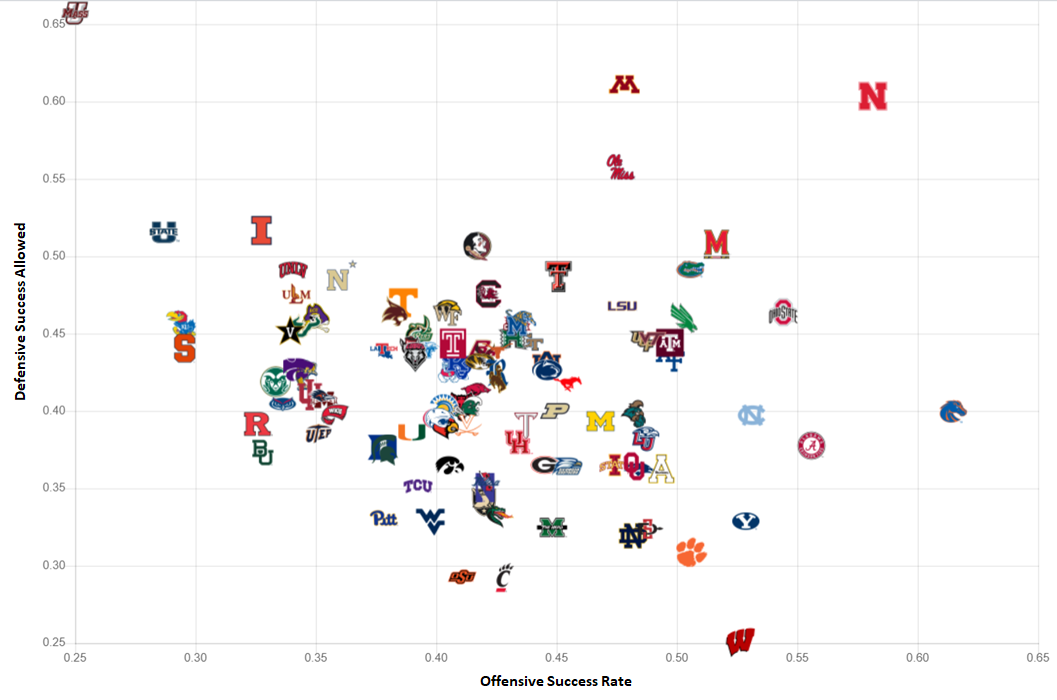
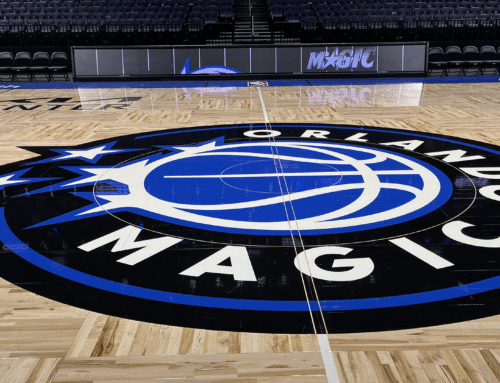
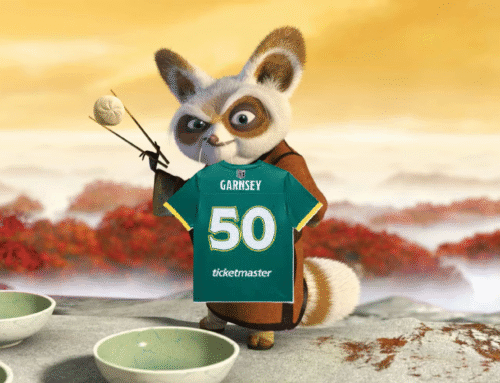
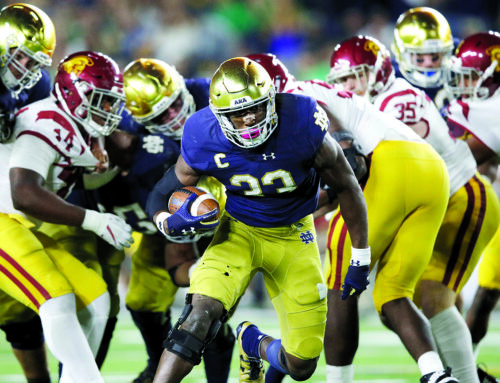
Since our offense is, as you say, slow and efficient, I wonder if it would be effective to go with an almost Navy-like strategy against Clemson. Very run-heavy (including designed runs for Book), go for it on every 4th and 3 or less, a handful of deep pass attempts when Clemson is way over-committed to the run.
I imagine Venables will dare us to throw deep, just like he did in the Cotton Bowl. Given what we’ve seen from the passing game year, I’m not sure we should take him up on that offer.
I would 100% be on board if they had Lawrence. Without him, think it depends how the defense is holding up and how the run game looks – how efficient and even within that if the unsuccessful plays are 2-3 yard gains on 1st down runs or stuffs or losses that throw us way behind schedule are common.
Agree. If it looks like we’re going to struggle with their offense, I would definitely start taking advantage of every risky opportunity. But until then, without Lawrence, I’d give Lea a chance to show what he can do. I believe in Lea, and I think 21 points wins this game.
Whether the ND offense can get there without taking chances on 4th and 3, I can’t say for sure. But I would probably hold off on going for it in those situations until we see how the D is holding up.
Sure, I wouldn’t be insanely reckless about fourth downs, but three things:
-We are actually pretty good at rushing in short yardage situations this year, which is unusual for Kelly’s teams. Might as well take advantage of it while we can.
-Being aggressive on fourth down worked well against FSU in 2014.
-I think a freshman QB is more likely to panic if possessions are very limited and he feels like he’s forced to score on every drive. Think about Pitt’s monster 8-minute drive against us in 2018 — totally changed the complexion of the game and forced Book into a sort of panic mode, which we fortunately escaped thanks to Narduzzi’s stupid fake punt.
I think you guys are 90% on the same page. It has to be fairly situational – how well have you been getting stops, where are you on the field, how long is it.
but for sure 1) no coward punting if it’s over midfield but short of a FG and reasonable distance to gain, 2) value every possession like it could decide the game. i.e. 4th and half a yard at your own 35, sneak it real quick.
I really hope we don’t kick FGs if we get a 4th and less than 5 at any point prior to the 4th quarter. I’m good with being reckless in that part of the field.
I wonder if this isn’t a great time to flip the script a little bit. Everyone I’m reading says ND will run the ball, clock control, take the air out, and limit Clem’s Son’s offense. So they’re game planning for that. Now is the time to juice it up, get Mayer and Tremble up the seam more, hit McKinley for some deep passes and run some hurry up. We kind of saw that Clem got knocked back a good bit against both BC because they fell behind early. In the end, BC’s 75th ranked FEI defense couldn’t contain Clem long enough but I think ND’s would. Get up by a few scores, rattle DJ U and put the butterflies in his stomach to have to take risks and see if he doesn’t make a few mistakes here and there.
I would love to see this. But those are things we aren’t particularly good at. We’ve tried this script a few times, with very little success, against much worse defenses.
That sounds like a recipe for a bunch of 30-second three and outs to me. It’s just not what we’re good at.
Plus, given that Clemson just played BC and Syracuse — both very much pass-first teams — it might be good to give them some schematic whiplash.
Given recent events, I’m going to say statistics and prognostications aren’t all they’re cracked up to be, and call for us to win, 31-21
I really, really, really do not need any more heart attacks induced by the upper Midwest this week.
I hate to have this perspective, but I have not been impressed at all by ND’s performance against top competition. Even without their soon-to-be #1 draft pick QB, I see them scoring enough on the ND defense (it helps to have a top RB and a 5 star backup QB).
If Clemson does what they should do on D (crowd the line), there will not be much room to run and the receivers will be hit very hard on the short crossing routes. In my view, the only chance ND has on offense is if Book can hit a few long passes.
My pessimism for this game seems to fit the general mood of The Athletic’s Mandel who said that he does not think ND will win because Clemson should be able to control ND’s one-dimensional offense.
Again, I hate to have this perspective, but I do not think ND is in the same league as Clemson.
Stewart Mandel predicted ND would finish in a 3-way tie for 3rd in the ACC. While I’m not extremely excited about playing Clemson, Stewart Mandel would be the last reason I would be pessimistic.
BUT DARKHORSE NORTH CAROLINA
A few thoughts:
1) Dabo confirmed tonight that Jones and Davis are both out. So they’re down four starters from their front seven in the first half (with Xavier Thomas out for targeting) and three for the game. I think that helps a lot for us moving the ball.
2) The last few defenses this talented ND faced moved the ball ok (UGA 2x). Clemson in the playoff not so much, but that was also an all-time team that held Bama with Tua and a million NFL caliber guys to 16 points the next week.
3) Gun to my head, I’d probably pick Clemson for somewhat similar reasoning. At the end of the day the passing game is the most important part of today’s game and Clemson has the edge there, although they are below their recent caliber at least a little at QB, OL (maybe decently), and WR (again compared to usual) there.
UMass’s terribleness is so bad that it is impressive. They may want to skip FCS all together and go straight to D-II
I have a question about SP+. It has Clemson rated 24.2 and us 21 this week. Does that mean it would consider them 3 point favorites on a neutral field, or would the betting line come from somewhere else?
Yep that’s correct. SP+ projection favors Clemson by a point this weekend with 2-points added for home field advantage for us. Have been trying to look for others but FEI has Clemson by 2.6 and FPI (on ESPN) has Clemson by around 7 before accounting for home field advantage. It’s also worth noting that none of these projections I believe account for any injuries or absences.